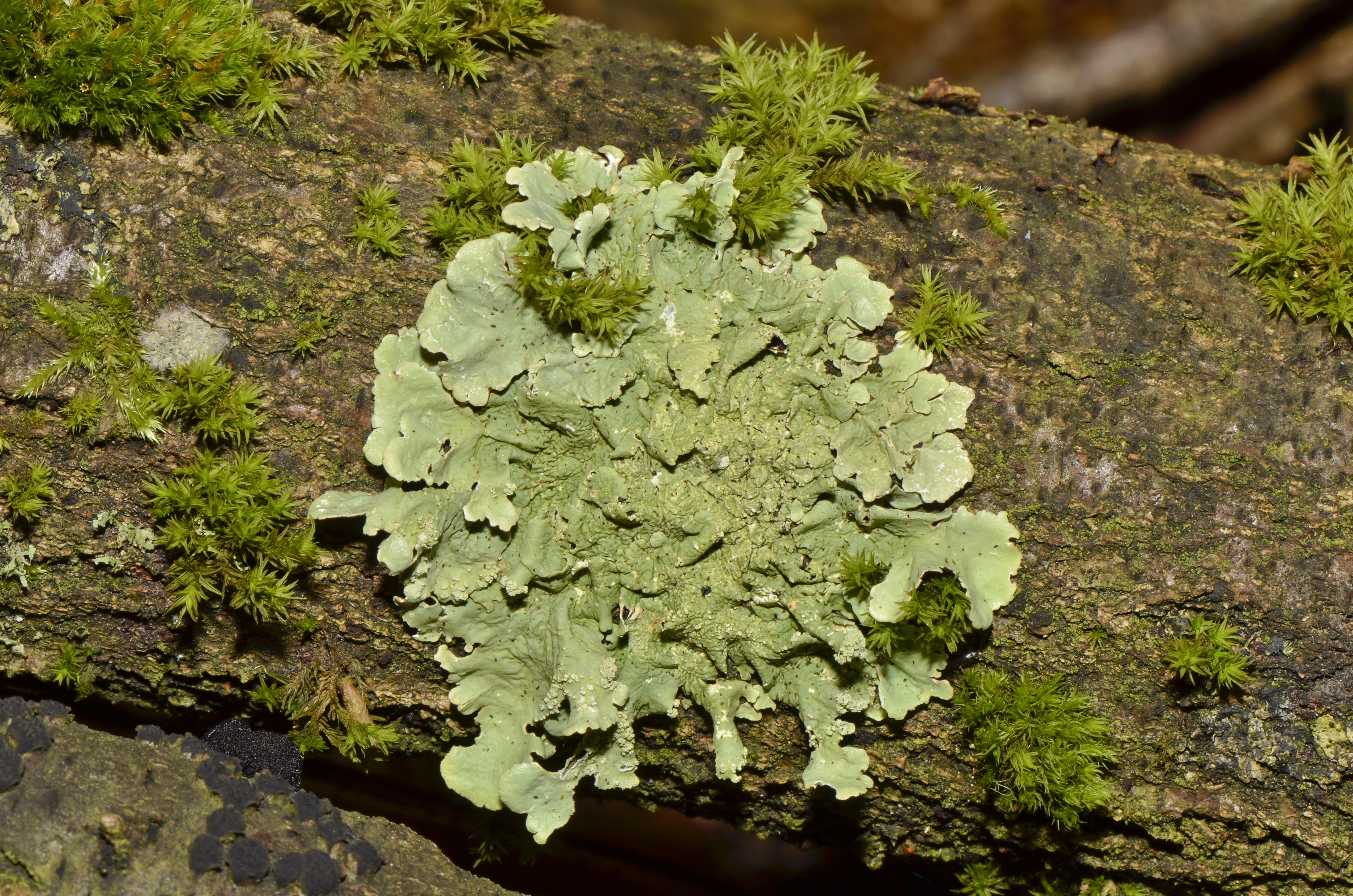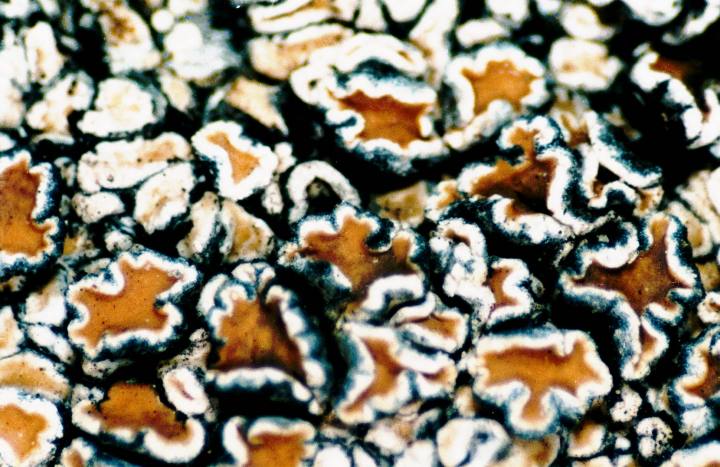|
Oxneria Fallax
''Oxneria fallax'', also known as the hooded sunburst lichen, is a small yellow-orange to red-orange foliose lichen that grows on bark or rarely on rock or bone. It is found all over the world except very dry areas, with 10 species common in North America.Field Guide to California Lichens, Stephen Sharnoff, Yale University Press, 2014, Lichen Flora of the Greater Sonoran Desert Region. Vol 2, Nash, T.H., Ryan, B.D., Gries, C., Bugartz, F., (eds.) 2001/ref> The nonfruiting body (thallus) grows in rosettes to 3 cm in diameter. The rosettes sometimes coalesce with each other. The lobes may appear divided at the tips. It is sometimes tightly appressed to the substrate (adnate), and sometimes not. The fruiting bodies (apothecia) are lecanorine, meaning that they are disc-like with a ring or rim of tissue around the disc that is made of tissue similar to the thallus. The tips of the lobes form hood shaped soralia that produce powdery greenish yellow soredia. It prefers growing on e ... [...More Info...] [...Related Items...] OR: [Wikipedia] [Google] [Baidu] |
Foliose Lichen
Foliose lichen is one of the morphological classes of lichens, which are complex organisms that arise from the symbiotic relationship between fungi and a photosynthetic partner, typically algae. This partnership allows lichen to live in diverse climates that can range from cold, dry mountains to wet, warm valleys. Lichens develop quite slowly with recorded growth rates of 0.01–27mm/year depending on the species. Their lifespan averages between 30 and 60 years. Lichens have a main body part called the thallus, which is composed of hyphae, and houses the cortex and medulla. The cortex contains the photosynthetic cells while the medulla allows for gas exchange and makes up the bulk of the lichen's thallus. There are three main types of lichens: crustose, foliose, and fruticose. Foliose lichen are characterised by flattened leafy thalli, and an upper and lower cortex. Many have numerous layers, which are stratified, and aid in identifying different types. Foliose lichens attac ... [...More Info...] [...Related Items...] OR: [Wikipedia] [Google] [Baidu] |
Lichen
A lichen ( , ) is a composite organism that arises from algae or cyanobacteria living among filaments of multiple fungi species in a mutualistic relationship.Introduction to Lichens – An Alliance between Kingdoms . University of California Museum of Paleontology. Lichens have properties different from those of their component organisms. They come in many colors, sizes, and forms and are sometimes plant-like, but are not plants. They may have tiny, leafless branches ( fruticose); flat leaf-like structures ( foliose); grow crust ... [...More Info...] [...Related Items...] OR: [Wikipedia] [Google] [Baidu] |
Thallus
Thallus (plural: thalli), from Latinized Greek (), meaning "a green shoot" or " twig", is the vegetative tissue of some organisms in diverse groups such as algae, fungi, some liverworts, lichens, and the Myxogastria. Many of these organisms were previously known as the thallophytes, a polyphyletic group of distantly related organisms. An organism or structure resembling a thallus is called thalloid, thallodal, thalliform, thalline, or thallose. A thallus usually names the entire body of a multicellular non-moving organism in which there is no organization of the tissues into organs. Even though thalli do not have organized and distinct parts ( leaves, roots, and stems) as do the vascular plants, they may have analogous structures that resemble their vascular "equivalents". The analogous structures have similar function or macroscopic structure, but different microscopic structure; for example, no thallus has vascular tissue. In exceptional cases such as the Lemnoid ... [...More Info...] [...Related Items...] OR: [Wikipedia] [Google] [Baidu] |
Adnation
Adnation in Angiosperms is the fusion of two or more whorls of a flower, e.g. stamens to petals". This is in contrast to connation, the fusion among a single whorl A whorl ( or ) is an individual circle, oval, volution or equivalent in a whorled pattern, which consists of a spiral or multiple concentric objects (including circles, ovals and arcs). Whorls in nature File:Photograph and axial plane flo .... References Plant anatomy {{botany-stub ... [...More Info...] [...Related Items...] OR: [Wikipedia] [Google] [Baidu] |
Apothecia
An ascocarp, or ascoma (), is the fruiting body ( sporocarp) of an ascomycete phylum fungus. It consists of very tightly interwoven hyphae and millions of embedded asci, each of which typically contains four to eight ascospores. Ascocarps are most commonly bowl-shaped (apothecia) but may take on a spherical or flask-like form that has a pore opening to release spores (perithecia) or no opening (cleistothecia). Classification The ascocarp is classified according to its placement (in ways not fundamental to the basic taxonomy). It is called ''epigeous'' if it grows above ground, as with the morels, while underground ascocarps, such as truffles, are termed ''hypogeous''. The structure enclosing the hymenium is divided into the types described below (apothecium, cleistothecium, etc.) and this character ''is'' important for the taxonomic classification of the fungus. Apothecia can be relatively large and fleshy, whereas the others are microscopic—about the size of flecks ... [...More Info...] [...Related Items...] OR: [Wikipedia] [Google] [Baidu] |
Lecanorine
A lichen has lecanorine fruiting body parts if they are shaped like a plate with a ring around them, and that ring is made of tissue similar to the main non-fruiting body part of the lichen.Field Guide to California Lichens, Stephen Sharnoff, Yale University Press, 2014, , page 279 The name comes from the name of the lichen genus ''Lecanora ''Lecanora'' is a genus of lichen commonly called rim lichens.Field Guide to California Lichens, Stephen Sharnoff, Yale University Press, 2014, Lichens in the genus ''Squamarina'' are also called rim lichens. Members of the genus have roughly ci ...'', whose members have such apothecia. If a lichen has lecanorine apothecia, the lichen itself is sometimes described as being lecanorine. References Lichenology {{lichen-stub ... [...More Info...] [...Related Items...] OR: [Wikipedia] [Google] [Baidu] |
Soralia
Soredia are common reproductive structures of lichens. Lichens reproduce asexually by employing simple fragmentation and production of soredia and isidia. Soredia are powdery propagules composed of fungal hyphae wrapped around cyanobacteria or green algae. These can be either scattered diffusely across the surface of the lichen's thallus Thallus (plural: thalli), from Latinized Greek (), meaning "a green shoot" or " twig", is the vegetative tissue of some organisms in diverse groups such as algae, fungi, some liverworts, lichens, and the Myxogastria. Many of these organisms ..., or produced in localized structures called soralia. Fungal hyphae make up the basic body structure of lichen. The soredia are released through openings in the upper cortex of the lichen structure. After their release, the soredia disperse to establish the lichen in a new location. References Fungal morphology and anatomy Lichenology {{lichen-stub ... [...More Info...] [...Related Items...] OR: [Wikipedia] [Google] [Baidu] |
Soredia
Soredia are common reproductive structures of lichens. Lichens reproduce asexually by employing simple fragmentation and production of soredia and isidia. Soredia are powdery propagules composed of fungal hyphae wrapped around cyanobacteria or green algae. These can be either scattered diffusely across the surface of the lichen's thallus Thallus (plural: thalli), from Latinized Greek (), meaning "a green shoot" or " twig", is the vegetative tissue of some organisms in diverse groups such as algae, fungi, some liverworts, lichens, and the Myxogastria. Many of these organisms ..., or produced in localized structures called soralia. Fungal hyphae make up the basic body structure of lichen. The soredia are released through openings in the upper cortex of the lichen structure. After their release, the soredia disperse to establish the lichen in a new location. References Fungal morphology and anatomy Lichenology {{lichen-stub ... [...More Info...] [...Related Items...] OR: [Wikipedia] [Google] [Baidu] |
Lichen Spot Tests
A spot test in lichenology is a spot analysis used to help identify lichens. It is performed by placing a drop of a chemical on different parts of the lichen and noting the colour change (or lack thereof) associated with application of the chemical. The tests are routinely encountered in dichotomous keys for lichen species, and they take advantage of the wide array of lichen products produced by lichens and their uniqueness among taxa. As such, spot tests reveal the presence or absence of chemicals in various parts of a lichen. They were first proposed by the botanist William Nylander in 1866. Three common spot tests use either 10% aqueous KOH solution (K test), saturated aqueous solution of bleaching powder or calcium hypochlorite (C test), or 5% alcoholic ''p''-phenylenediamine solution (P test). The colour changes occur due to presence of particular secondary metabolites in the lichen. There are several other less frequently used spot tests of more limited use that are employe ... [...More Info...] [...Related Items...] OR: [Wikipedia] [Google] [Baidu] |






